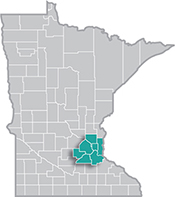 The Minneapolis-St. Paul metropolitan area is a national leader in finance, advanced manufacturing, agriculture and retailing.
The Minneapolis-St. Paul metropolitan area is a national leader in finance, advanced manufacturing, agriculture and retailing.
Medical devices, electronics and processed foods are strong suits recognized globally.
Want the freshest data delivered by email? Subscribe to our regional newsletters.
7/19/2023 9:00:00 AM
Tim O'Neill
With thousands of current vacancies and projected future openings, Home Health & Personal Care Aides have recently been ranked as the Seven-County Twin Cities Metro Area's most in-demand occupation. This is according to DEED's Occupations in Demand (OID) tool. Other occupations at the top include Registered Nurses, Retail Salespersons, Cashiers, and Customer Service Representatives. In all, DEED's OID tool reveals 300 specific occupations with high or very high demand in the region.
DEED's OID tool lists current career opportunities in a region as determined by regularly updated local labor market data. These lists, which are available for the State of Minnesota and six planning regions, are calculated based on the following data sources:
Along with a relative demand ranking, the OID lists also reveal job characteristics, including wages, employment outlook, educational requirements, and on-the-job training requirements. Table 1 highlights some of this data for the top 15 occupations in demand in the Metro Area. For example, Home Health and Personal Care Aides typically require a high school diploma or equivalent for entry, have a median annual wage of $33,154, and are projected to grow by 26.5% through 2030. This growth rate is equivalent to approximately 67,700 net new and replacement openings in the region.
| Table 1. Metro Area Top Occupations in Demand, 2023 | |||||
|---|---|---|---|---|---|
| Occupation | 25th Percentile Wage | Median Wage | 2020-2030 Growth Rate | 2020-2030 Projected Openings | Education Requirements |
| Home Health and Personal Care Aides | $30,764 | $33,154 | +26.5% | 67,733 | High school diploma or equivalent |
| Registered Nurses | $84,022 | $91,157 | +7.1% | 12,644 | Associate degree |
| Retail Salespersons | $30,201 | $33,769 | -3.0% | 25,241 | High school diploma or equivalent |
| Cashiers | $28,822 | $30,580 | -9.4% | 26,296 | High school diploma or equivalent |
| Customer Service Representatives | $38,177 | $47,638 | -3.9% | 19,515 | High school diploma or equivalent |
| First-Line Supervisors of Food Preparation and Serving Workers | $38,057 | $41,302 | +18.0% | 6,041 | High school diploma or equivalent |
| Software Developers | $102,173 | $117,626 | +23.8% | 14,840 | Bachelor's degree |
| Nursing Assistants | $39,924 | $43,351 | +4.2% | 8,253 | Postsecondary non-degree award |
| First-Line Supervisors of Retail Sales Workers | $42,078 | $49,618 | -6.2% | 3,750 | High school diploma or equivalent |
| Laborers and Freight, Stock, and Material Movers, Hand | $38,676 | $44,689 | +7.4% | 13,224 | High school diploma or equivalent |
| Stockers and Order Fillers | $32,629 | $36,894 | +2.7% | 15,856 | High school diploma or equivalent |
| Heavy and Tractor-Trailer Truck Drivers | $51,037 | $61,872 | +4.0% | 7,605 | High school diploma or equivalent |
| Fast Food and Counter Workers | $30,018 | $31,619 | +12.4% | 47,038 | High school diploma or equivalent |
| Waiters and Waitresses | $23,936 | $24,621 | +17.4% | 17,230 | High school diploma or equivalent |
| Janitors and Cleaners | $31,803 | $37,572 | +5.6% | 18,669 | High school diploma or equivalent |
| Source: DEED Occupations in Demand | |||||
Out of 22 major occupational groups, Business & Financial Operations had the most occupations within the Metro Area's top 100 occupations in demand. Food Preparation & Serving Related occupations and Office & Administrative Support occupations tie with the second most occupations in demand in the top 100. Other occupational groups with many occupations at the top include Transportation & Material Moving, Sales & Related, Management, and Healthcare Practitioners & Technical occupations.
By educational attainment requirements, occupations requiring a high school diploma or less make up the largest share of in demand occupations in the Metro Area. In fact, those occupations requiring a high school diploma or less account for about half (49.0%) of the region's 300 in demand occupations. Just over one-third (37.0%) of the region's in demand occupations require a bachelor's degree or more to start. The remaining 14% of occupations in demand require either postsecondary non-degree awards or an Associate Degree.
By wage, about nine out of every 10 of the Metro Area's occupations in demand had median hourly wages that met or exceeded the region's basic needs Cost of Living for an individual with no children, which equaled $18.05 in 2022. About three-in-four of the Metro Area's occupations in demand had median hourly wages that met or exceeded the region's basic needs cost of living for a typical family of three, which was $21.70 in 2022.
Contact Tim O'Neill, Labor Market Analyst, at timothy.oneill@state.mn.us.